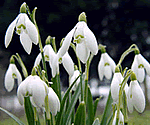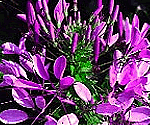
Sage of Bethlehem
The Sage is any species of the large genus Salvia, aromatic herbs or shrubs of the family Labiatae. The common sage of herb gardens is S. officinalis, a strongly scented shrubby perennial, and native from S Europe to Asia Minor.
The dried leaves are used as seasoning; sage tea, once popular as a beverage, has also been used as a domestic remedy for colds and other ailments. Prized since ancient times, common sage was thought to prolong life and to increase wisdom by strengthening the memory and hence the name.
From the thirteenth century onwards, a tradition evolved of displaying models of the stable, crib and the Holy family in churches and homes on the occasion of Christmas. Nowadays, the stable is filled only with hay or straw but great care was taken in previous times in choosing appropriate flowers for inclusion in the stable scene. Each was chosen for its fragrance or symbolism. Legends grew around the flowers, and appropriate names were given to them.
In Lincolnshire, the name given to garden mint was Sage of Bethlehem. Botanically, the sage is a garden labiate plant, often used in culinary preparations like stuffing for goose. Belonging to the Salvia family, the sage expresses goodness, virtue and a high esteem for the person offered this flower. The sage was dedicated to Mary, and carries significant religious significance.
Sage is classified in the division Magnoliophyta, of the class Magnoliopsida, and order Lamiales.

Snowdrop
Flowers are often the source of great poetic inspiration. As we contemplate Nature’s diversities, we find the delicate wonder of white snowdrops causing the poet Wordsworth to express in sheer awe:
Love Flower, hemmed in with snows,
And white as they But hardier for, once more I see thee bend
Thy forehead as if fearful to offered,
Like an unbidden guest….
Chaste Snowdrop, venturous harbinger of spring,
And pensive monitor of fleeting years.
A snowdrop is a drooping bell-shaped white flower, of early spring, which resembles the colour or rather the translucent whiteness of the crystals and flecks of snow. Thus the name ‘snowdrop’ came about. Scientifically, this flower is known as Galanthus nivalis, belonging to the Amarhyllidaceae family. Interestingly, a snowdrop is symbolic of consolation; maybe just gazing at the flower soothes the hearts wounds.

Spider Flower
Some things, some human emotions and instincts remain eternal, evergreen. Love, of course. And the best way to express such common yet unique feelings is to be original in expression, thus carving an immemorial niche in the heart of one’s beloved. As Klopstock says, ‘one of the best uses of originality is, to say common things in an uncommon way.’
So, when you receive a single spider flower one special evening, what do you understand of this mysterious message? How would you react? Well, a spider flower is a special way of asking one’s beloved: Will you elope with me? Romantic, isn’t it?
A spider flower is an annual of the genus Cleome, bearing clusters of white or pink flowers, with long stamens reminiscent of spider’s legs. Etymologically, the word ‘spider’, which is a derivative of the Old English term ‘spithra’, means ‘to spin’. So, next time, you are romantically inclined to spin the magic of love and entrancement over your beloved, the special way to propose elopement and a lifetime of togetherness would be to convey the secret message of love enfolded within the fragrant petals of spider-flower.

Sunflower
The sunflower is testimony to the majesty of the sun. The ‘sun-dance’ is a North-American Indian ceremonial dance performed in honour of the sun. The ‘sun-flower’ is said to be so photosensitive that it always turns towards the light of the sun. Sunflower is commonly associated with pride and adoration. However, the wise saying – ‘all that glitters is not gold’ pertains to this majestic yellow flower’.
Ah! Sunflower!
Ah! Sunflower, weary of time,
Who countest the steps of the sun,
Seeking after that sweet golden clime
Where the traveller’s journey is done;
Where the youth pined away with desire
And the pale virgin shrouded in snow,
Arise from their graves, and aspire
Where my sunflower wishes to go!
William Blake, 1794
A plant of the genus Helianthus of the family Asteraceae, the sun is attributed with a number of uses. The nutritious seeds were eaten raw, made into a meal, and even sometimes used as a source of hair oil. A yellow dye was obtained from the flower heads, and a fibre from the stalks. Today the common sunflower is widely cultivated; it is particularly valued in the countries of the former Soviet Union, where the seeds are made into bread. The seeds are almost universally used as a poultry food and principally as the source of oil utilized for such purposes as cooking and soap making.
The common sunflower is the state flower of Kansas, and a sunflower is regarded as the floral emblem of Peru, where this flower was much reverenced by the Aztecs, and in their temples of the Sun, the priestesses were crowned with Sunflowers and carried them in their hands. The early Spanish conquerors found in these temples numerous representations of the Sunflower wrought in pure gold. The giant sunflower, also called the ‘tall sunflower’ is a composite plant, Helianthus giganteus with very large yellow flower heads.
Sunflowers are classified in the division Magnoliophyta of the class Magnoliopsida and order Asterales.

Sweet Pea
The Sweet Pea or Lathyrus odoratus is a highly scented flowering plant.Its ancestry can be traced back to the 17 th century and is native to the eastern Mediterranean region from Sicily east to Crete. The sweet pea plant has qualities of rich coloured flowers that possessed a powerful and attractive fragrance.
The sweet pea plant reached the shores of England, courtesy of a Sicilian monk, Franciscus Cupani, who sent seeds to Dr. Robert Uvedale, a schoolmaster of Enfield, in 1699. Cupani clearly considered the plant to be of some importance, because he also sent seed to Caspar Commelin in Amsterdam at the same time.
An individual sweet pea bloom consists of three or four flowers (or florets) on a stem.
Sweet Pea’s come in a range of different colours such as purples, pinks, creams and salmons. It is an annual climbing plant, growing to a height of 1-2 m but, unlike most peas, the seeds of the sweet pea should not be eaten as they are poisonous.
Sweet peas mean “delicate pleasures”. They are often grown by gardeners for their bright colours and the sweet fragrance that gives them their name.
The name “sweet pea” is believed to have first been used by the poet Keats (1795-1821).
Sweet Pea (Delicate Pleasures)
“Here are sweet peas, on tip-toe for a flight
With wings of gentle flusho’er delicate white,
And taper fingers catching at all things
To bind them all about with tiny rings.” Keats

Sweet William
The gift of a Sweet William indicates yearning, a wish for a smile! This fragile blossom is a garden pink, scientifically named Dianthus barbatus, with bearded petals. Sweet William is a Pink having clusters of small, variously coloured flowers. It is also referred to as bunch pink.
Famous for its spicy fragrance, this blossom belongs to the popular group of ornamental pinks. Of course, even flower experts differ in their interpretation of the ‘true meaning’ of this flower. A gift of sweet William requests, “Sweet lady, grant me one smile!”
